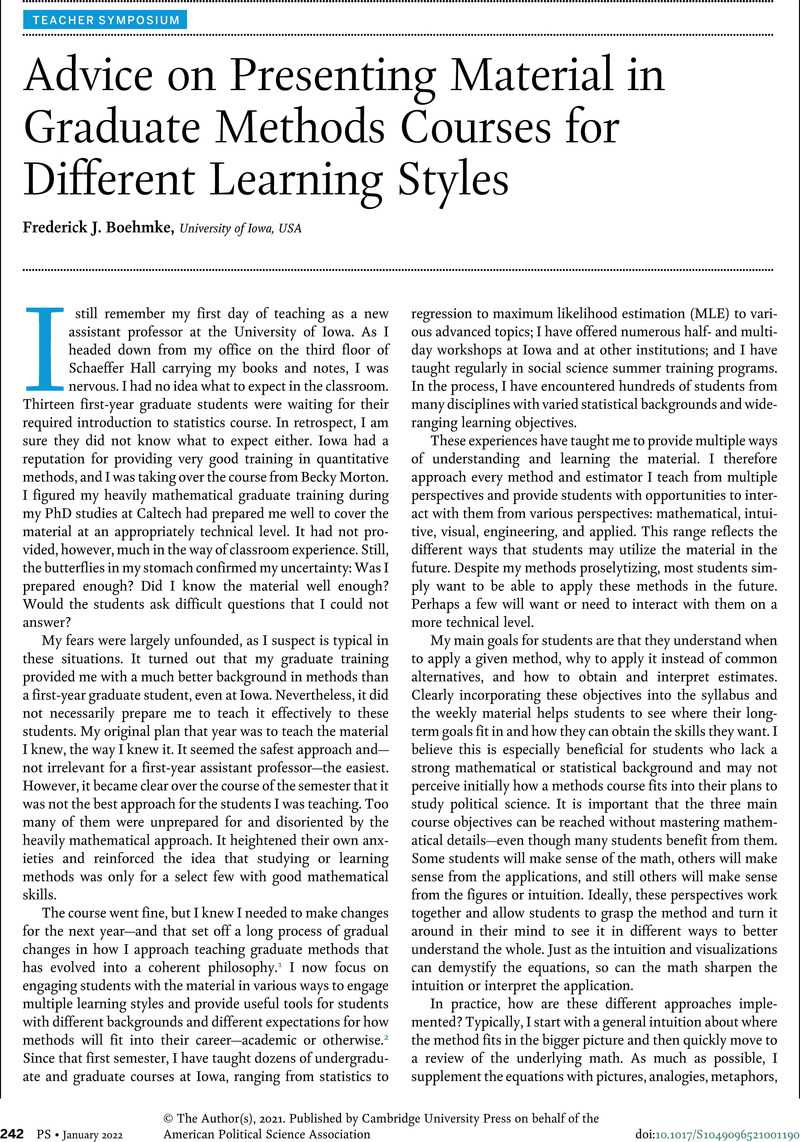No CrossRef data available.
Article contents
Advice on Presenting Material in Graduate Methods Courses for Different Learning Styles
Published online by Cambridge University Press: 21 December 2021
Abstract
An abstract is not available for this content so a preview has been provided. Please use the Get access link above for information on how to access this content.

- Type
- Teaching Political Methodology
- Information
- Copyright
- © The Author(s), 2021. Published by Cambridge University Press on behalf of the American Political Science Association
References
REFERENCES
Braun, W. John; Bethany, J. G. White; and Craig, Gavin. 2014. “R Tricks for Kids.” Teaching Statistics 36 (1): 7–12. https://doi.org/10.1111/test.12016.CrossRefGoogle Scholar
Carsey, Thomas M., and Harden, Jeffrey J.. 2013. Monte Carlo Simulation and Resampling Methods for Social Science. Los Angeles: SAGE Publications.Google Scholar
Carsey, Thomas M., and Harden, Jeffrey J.. 2015. “Can You Repeat That Please? Using Monte Carlo Simulation in Graduate Quantitative Research Methods Classes.” Journal of Political Science Education 11 (1): 94–107.CrossRefGoogle Scholar
Cassidy, Simon. 2004. “Learning Styles: An Overview of Theories, Models, and Measures.” Educational Psychology 24 (4): 419–44.CrossRefGoogle Scholar
Christou, Nicolas, and Dinov, Ivo D.. 2010. “A Study of Students’ Learning Styles, Discipline Attitudes, and Knowledge Acquisition in Technology-Enhanced Probability and Statistics Education.” Journal of Online Learning and Teaching 6 (3). http://jolt.merlot.org/vol6no3/dinov_0910.htm.Google ScholarPubMed
Garfield, John, and Ben-Zvi, Dani. 2007. “How Students Learn Statistics Revisited: A Current Review of Research on Teaching and Learning Statistics.” International Statistical Review 75:372–96.CrossRefGoogle Scholar
Heckman, James J. 1979. “Sample Selection Bias as a Specification Error.” Econometrica: Journal of the Econometric Society 47 (1): 153–61.CrossRefGoogle Scholar
Kreitzer, Rebecca J., and Boehmke, Frederick J.. 2016. “Modeling Heterogeneity in Pooled Event History Analysis.” State Politics and Policy Quarterly 16 (1): 121–41.CrossRefGoogle Scholar
Lai, Brian. 2003. “Examining the Goals of US Foreign Assistance in the Post–Cold War Period, 1991–96.” Journal of Peace Research 40 (1): 103–28.CrossRefGoogle Scholar
Licht, Amanda A. 2011. “Change Comes with Time: Substantive Interpretation of Nonproportional Hazards in Event History Analysis.” Political Analysis 19 (2): 227–43.CrossRefGoogle Scholar
Little, Roderick J. A., and Rubin, Donald B.. 2020. Statistical Analysis with Missing Data, 3rd Edition. Hoboken, NJ: John Wiley & Sons.Google Scholar
Long, J. Scott. 1997. Regression Models for Categorical and Limited Dependent Variables, 1st Edition, Volume 7. Los Angeles: SAGE Publications.Google Scholar
Mooney, Christopher Z. 1997. Monte Carlo Simulation. No. 116. Los Angeles: SAGE Publications.CrossRefGoogle Scholar
Nieman, Mark David. 2015. “Statistical Analysis of Strategic Interaction with Unobserved Player Actions: Introducing a Strategic Probit with Partial Observability.” Political Analysis 23 (3): 429–48.CrossRefGoogle Scholar
Sigal, Matthew J., and Chalmers, R. Philip. 2016. “Play It Again: Teaching Statistics with Monte Carlo Simulation.” Journal of Statistics Education 24 (3): 136–56.CrossRefGoogle Scholar


